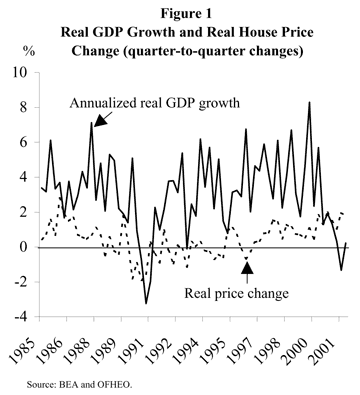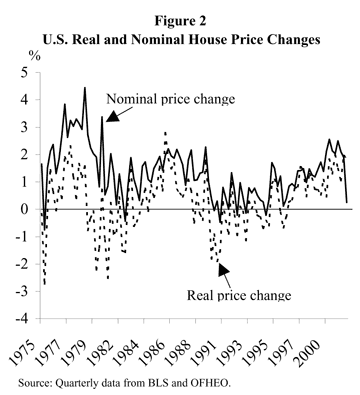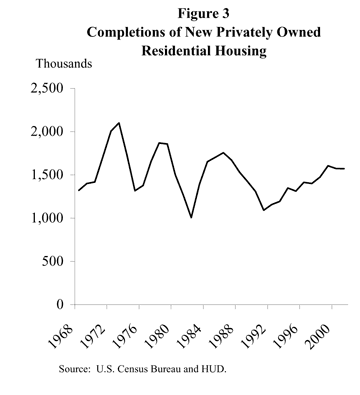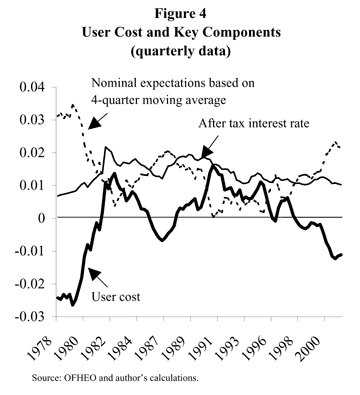It is somewhat surprising that house prices in most parts of the nation have stayed high despite the downturn in the economy. As Figure 1 shows, real (inflation-adjusted) house price changes became negative with GDP growth during the last recession in 1991; but this time, they have remained positive and appear to be firm.
- House price dynamics
- Supply and demand in housing markets
- A simple model of the user cost
- Conclusion
- References

It is somewhat surprising that house prices in most parts of the nation have stayed high despite the downturn in the economy. As Figure 1 shows, real (inflation-adjusted) house price changes became negative with GDP growth during the last recession in 1991; but this time, they have remained positive and appear to be firm. The strength in the housing market also contrasts vividly with the declines in the stock market over the past couple of years. Indeed, many of the regions where house price appreciation has been strongest over the past two years have large concentrations of high-tech firms; tumbling share prices and job losses in the high-tech sector would seem to represent a large shock to housing demand, yet year-over-year price changes in places like San Francisco remain stubbornly positive. Declining mortgage interest rates may have helped to support prices. But interest rates also fell around the time of the last recession, and that did not prevent real house prices from declining.
In this Economic Letter, I outline some of the empirical facts about house prices that have been documented in the real estate literature and explore some of the determinants of supply and demand that lead to house price dynamics. After focusing particularly on demand, I attempt to reconcile a current estimate of housing demand with our position in the business cycle.
Figure 2 helps illustrate two well-known facts about house prices. The figure plots real and nominal quarterly house price changes for the U.S., based on data from the Office of Federal Housing Enterprise Oversight’s house price index. First, although it is relatively unusual to observe declines in nominal house prices—at least at the national level—declines in real prices are relatively more common. One important point to keep in mind, however, is that while declines in nominal house prices are relatively rare, the volume of housing market transactions tends to be more responsive to a slowing economy. A flattening out of an observed price series may in fact mask a buildup of inventory of unsold houses.

Second, real house price changes appear to be persistent; that is, positive price changes tend to be followed by more positive price changes, and vice versa for negative price changes. This observation has stoked considerable interest amongst researchers because, normally, we expect asset prices to adjust immediately to reflect new information about fundamental value, not gradually over time (see Meese and Wallace 1994 for some important empirical work on this issue). Persistence in house prices could indicate that housing markets are inefficient, either in the sense that the market takes time to clear, or that prices and expectations of future price changes are set in a backward-looking manner. An alternative explanation for the persistence in house prices is that prices depend directly on economic variables, such as job growth and changes in personal income, that are themselves persistent.
Supply and demand in housing markets
Simple economic models demonstrate how changes in house prices come about from changes in supply and demand. Disentangling supply and demand shocks and assessing their impact on house prices is, of course, a challenging empirical problem in general. For assessing the current situation, however, this “identification” problem may be mitigated by the fact that there appears to be little evidence of sudden supply shocks over the past couple years. Figure 3 shows that the supply of newly completed single family homes rose steadily through the 1990s, peaking at the end of the decade, and has remained close to its long-run average ever since.

One of the most interesting features of Figure 3 is the apparent change in the behavior of new construction beginning in the early 1990s. Before then, the series was volatile, and thereafter it has been relatively smooth. This 1990 breakpoint may not be coincidental. Following the banking crisis in the late 1980s and early 1990s, capital market discipline and scrutiny from banking regulators may have acted as a check to the boom and bust dynamics that seem to characterize development in prior periods. In that case, it is possible that developers have been constrained in their ability to bring new housing stock to market and may not have overbuilt during the economic expansion. If housing supply has leveled off while housing demand has remained strong, then that interplay helps explain why house prices may have remained firm at this point of the business cycle.
What about demand? The demand for housing likely depends on variables such as job growth, growth in personal income, changes in demographics, and the cost of buying housing. This cost includes the actual price and the financing cost. Most studies of housing demand recognize the user cost of housing capital (for example, Poterba 1984) as an important determinant of financing costs. Decreases in the user cost are thought to accompany increases in the demand for housing and vice versa. Technically, the user cost measures the willingness of a household to trade off housing consumption for nonhousing consumption over the course of a single period (i.e., the user cost is a marginal rate of substitution). In competitive settings, the user cost is simply the per-period rental cost of the housing asset. The principal advantage of looking at the user cost, as opposed to looking only at changes in rents, is that the user cost offers more insight into which variables are driving changes in costs and, hence, driving changes in demand.
A simple model of the user cost
A typical specification of the user cost includes a mortgage interest rate, a property tax rate, a maintenance cost, a deduction for depreciation, and a term reflecting expectations about future price appreciation. The interest payment and property taxes terms are calculated on an after-tax basis. Expected appreciation serves to lower the user cost, because, if that appreciation eventually comes to pass, it will benefit the owner when she sells the house and can conceivably allow her to alter her current decisions about saving and consumption.
The user cost would be extremely easy to measure were it not for the inherently unobservable expectations term. In this model, I define expectations as the four-quarter moving average of past price changes. Clearly, these are naïve expectations. However, I have found that the results based on more sophisticated measures are not markedly different from those based on the crude measure used here.
The analysis below is based on a “stripped-down” model of the user cost that emphasizes the three key variables that contribute to its dynamics: taxes, mortgage interest rates, and expectations. For this exercise, I focus on quarterly changes. Thus, the interest rate series is converted to a quarterly rate. The marginal tax rate used is the top marginal rate prevailing at the time of the observation.

Figure 4 presents estimates of this stripped-down version of the user cost. Much of the short-run variation in the user cost comes from changes in mortgage interest rates and expected appreciation rates. High mortgage rates in the early 1980s put significant upward pressure on the user cost. But note that the higher mortgage rates in the late 1980s can be partially offset by expected appreciation rates. For the current situation, it is interesting to note that this particular specification of the user cost indicates much higher demand at present than during the last recession in 1991. This is not entirely due to the decline in mortgage interest rates. Indeed, after-tax mortgage interest rates fell faster during the last recession than during the current one. In this model, the strong demand at the current time is due primarily to strong expectations for future price appreciation.
This result raises the question of whether house prices are, in fact, backward-looking or forward-looking. In the model, they were assumed to be backward-looking; specifically, expectations for appreciation in the next quarter were defined to be equal to the average appreciation over the past four quarters (as argued above, more sophisticated techniques that use different moving average lengths or incorporate additional economic data yield the same basic results). Short of conducting a survey of housing market participants, economists are forced to estimate expectations using past data, and this reliance forces us to contend with the strong persistence in the data as seen in Figure 2.
The question of whether true expectations are forward-looking or backward-looking is extremely important, however. If expectations are forward-looking, then today’s prices are likely to be justified and will continue to hold up until news arrives that makes people change their expectations. If not, then the market will eventually “learn” that fundamentals are weak and prices will adjust.
House prices in the U.S. appear to be more firm than they were at this phase of the last business cycle. According to one measure of housing demand, the reason house prices are firm is not so much because of the drop in mortgage interest rates as because of expectations. On its own, this conclusion—prices are high today because they are expected to be high in the future—would be unsettling. But the strong expectations in the housing market are mirrored in other parts of the economy. These expectations could, of course, be proven wrong. However, indicators ranging from interest rate differentials to trends in consumer savings (see Marquis 2002), provide a substantial amount of economic data suggesting that investors and consumers foresee a relatively mild recession and a return to solid economic growth.
John Krainer
Economist
References
Marquis, M. 2002. “What’s Behind the Low U.S. Personal Saving Rate?” FRBSF Economic Letter 2002-09 (March 29).
Meese, R., and N. Wallace. 1994. “Testing the Present Value Relation for Housing Prices: Should I Leave My House in San Francisco?” Journal of Urban Economics 35, pp. 245-266.
Poterba, J. 1984. “Tax Subsidies to Owner-Occupied Housing: An Asset Market Approach.” Quarterly Journal of Economics (November) pp. 729-752.
Opinions expressed in FRBSF Economic Letter do not necessarily reflect the views of the management of the Federal Reserve Bank of San Francisco or of the Board of Governors of the Federal Reserve System. This publication is edited by Anita Todd and Karen Barnes. Permission to reprint portions of articles or whole articles must be obtained in writing. Please send editorial comments and requests for reprint permission to research.library@sf.frb.org